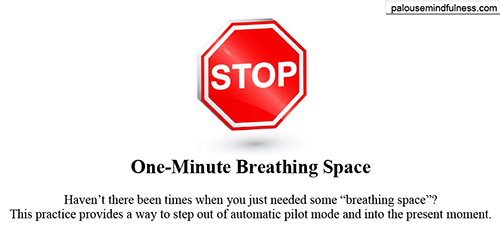Everyday Mindfulness & Meditation
Counseling & Psychological Services
UNHOOK YOURSELF FROM STRESS: SKILLS & TIPS
Stress is your body's way of responding to demands or threats in your environment (whether real or imagined). In limited doses, stress is not a bad thing... It can actually help you to perform better in pressure situations, and motivate you to rise to the occasion. Your body's stress response can help you to stay alert, energized, and ready to respond. It can even save your life by augmenting your physical strength, your concentration and reaction time, and your ability to tolerate pain.
But when stress doesn't let up, when you find yourself besieged by chronic demands, and when your stress levels are magnified by incessant worry, unskillful coping, and lack of support... It can feel very overwheming. Ultimately, the harmful effects of stress can have a deep impact on multiple aspects of life
.

Stress Symptoms, Signs, and Causes
Improving Your Ability to Handle Stress isn't always bad. In small doses, it can help you perform under pressure and motivate you to do your best. But when you're constantlyrunning in emergency mode, your mind and body...READ MORE ABOUT HANDLING STRESS
While there is no substitute for ongoing support from a significant other, a helping professional, or mindfulness and meditation practice, there are various skills that require a lower investment of time and commitment. Below are some resources that shed more light on how you can mindfully "unhook" from stress in the moment. These skills won't make all of your stress go away, but they can "take the edge off" and let you proceed with life. Try one out next time you notice your stress level rising...
General Stress Management
This TED Talk by health psychologist Kelly McGonigal is a great starting point for understanding stress, and how to respond effectively.

Stress Management
While it may seem like there’s nothing you can do about stress at work and home, there are steps you can take to relieve the pressure and regain control. Using self-help rechniques for dealing with stress helps you break the hold stress has on your life, so you can be happier, healthier, and more productive. It may seem like there's nothing you can do about stress but you have a lot more control than you might think.

Quick Stress Relief
Learn how to use the power of your senses to relieve stress on the spot and stay calm, productive, and focused—no matter what life throws at you. Quick stress relief using your senses to relieve stress on the spot. Ever wish a stress superhero could save you from the tension of traffic jams, chaotic meetings, arguments with your spouse, or a toddler's tantrums? Well, you can be your own stress-busting superhero.
Diaphragmatic/ Belly Breathing
Diaphragmatic breathing, or belly breathing, is one of the simplest and most effective ways to take the edge off stress.
Here is another belly breathing tutorial. Feel free to sit, stand, or lay down, whatever is most comfortable.
The STOP Technique, a.k.a. "The One -Minute Breathing Space"

If you remember nothing else, remember the word "STOP" (palousemindfulness.com)
S - Stop and take Stock: Checking in to head/heart/body
Bring yourself into the present moment by deliberately asking: What is my experience right now?
- Thoughts… (what are you saying to yourself, what images are coming to mind.)
- Feelings… (enjoying, neutral, upset, excited, sad, mad, etc.)
- Sensations… (physical sensations, tightness, holding, lightness, etc.)
Acknowledge and register your experience, even if it is uncomfortable.
T - Take a Breath: directing awareness to breathing
Gently direct full attention to breathing, to each inbreath and to each outbreath as they follow, one after the other. Your breath can function as an anchor to bring you into the present and help you tune into a state of awareness and stillness.
O - Open and Observe: expanding awareness outward
Expand the field of your awareness around and beyond your breathing, so that it includes a sense of the body as a whole, your posture, and facial expression, then further outward to what is happening around you: sights, sounds, smells, etc. As best you can, bring this expanded awareness to the next moments…
P - Proceed / New Possibilities: continuing without expectation
Let your attention now move into the world around you, sensing how things are right now. Rather than react habitually/mechanically, you can be curious/open, responding naturally. You may even be surprised by what happens next after having created this pause…
Want a copy of this STOP method?
Download the STOP FLIER from palousemindfulness.com.
Dr. Susan Bauer-Wu explains the STOP technique.
Progressive Muscle Relaxation
Progressive muscle relaxation exercise
Muscle tension is often associated with high levels of stress. Progressive muscle relaxation is a way of providing relief and relaxation. This version takes less than 4 minutes.
Stress and the Mind
This collection of videos offers an introduction to the quirks that make our minds so good at amplifying stress, along with skills and tips on how to unhook from stressful thoughts and drop the struggle with distressing feelings.
Evolution of the Human Mind
The Sushi Train Metaphor
The Chessboard Metaphor
The Struggle Switch
Labeling Thoughts and Feelings
One of the hallmarks of acute stress is the sense that everything is coming at us hard and fast: thoughts, emotions, and physiological reactions. During these times, we can fall prey to the belief that we are overwhelmed and powerless. Noticing and naming our thoughts and feelings can be an effective way to create some space, or psychological distance, from the thoughts and feelings associated with stress. Sometimes jotting them down helps as well. Use the following brief articles as a guide...

"Label" Your Way to Inner Peace Mindfulness meditation has become a favorite stress management technique because it is effective and brings many lasting benefits.

How Labels Help: Tame Reactive Emotions by Naming Them - Mindful If we can see a strong emotion—like anger—welling up, then we don't have to be it.

